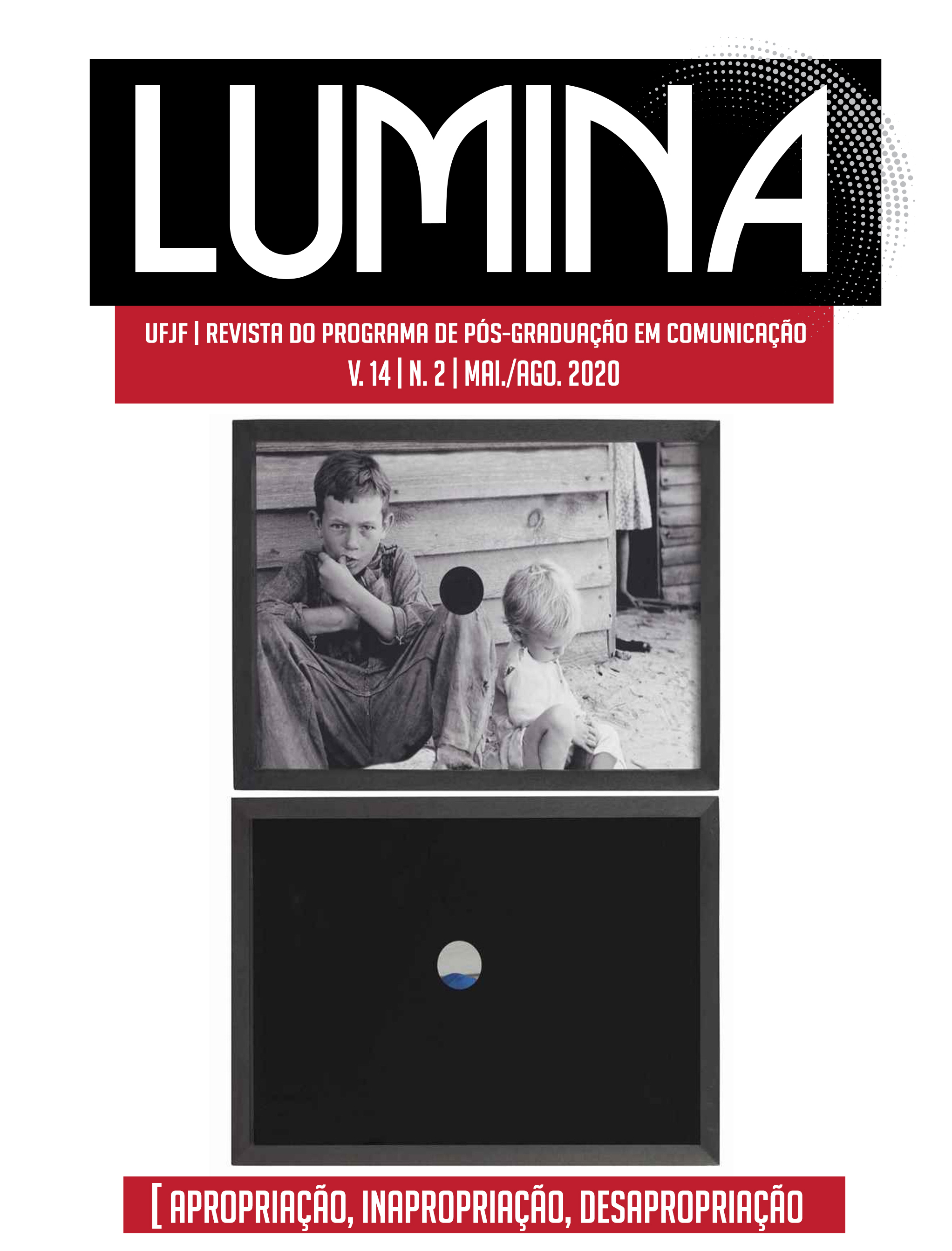Cinema, história, memória e verdade: found footage e apropriação em Wajda
DOI:
https://doi.org/10.34019/1981-4070.2020.v14.30380Palabras clave:
Cinema, História, Andrzej Wajda, FootageResumen
Este artigo discute a apropriação de arquivos de filmes e vídeos footage para propostas representacionais de fundo histórico no cinema, através de alguns trabalhos do cineasta Andrzej Wajda (Trilogia da guerra 1954-1958, Homem de mármore 1976 e Katyn 2007). Embora a relação dos estudos históricos com as imagens tenha sido sempre questionada pelos pesquisadores da área, ao longo do século XX a utilização da fotografia, do cinema e do vídeo, em geral, foi cada vez mais incorporada e ampliada ao campo histórico. Wajda foi um cineasta que, por seu viés nacionalista, teve aproximação marcante com o gênero histórico, adotando, desde sua estreia, imagens de arquivos fílmicos (footage) mescladas ao ficcional. Contudo, a apropriação dos footage por Wajda não se limitou, como era comum aos anos 1930, a um caráter puramente documental ou ilustrativo, mas tornou-se, a exemplo de outros artistas, um recurso criativo e crítico. Assim, nas obras aqui examinadas – Trilogia da guerra (Geração, Canal e Cinzas e diamantes), Homem de mármore e, mais enfaticamente, Katyn –, é possível atestar como o recurso ao footage não apenas fornece outros significados à história oficial, mas engendra uma meta-história, tanto da história oficial como das formas canônicas de se buscar a memória e a história. Tomando o conceito de “efeito de arquivo”, elaborado por Jamie Baron (2012, 2014), esta análise busca, ainda, destacar o papel determinante da recepção no estabelecimento dos sentidos de “documento” e dos elementos considerados “ficcionais” no uso dos arquivos de imagens.
Descargas
Citas
APPLEBAUM, Anne. A movie that matters. The New York Review of Books, v. 14, fev. 2008, Online. Disponível em: http://www.nybooks.com/ articles/21012. Acesso em: 31 jul. 2020.
BARON, Jamie. The archive effect: archival footage as an experience of reception. Projections, v. 6, n. 2, p. 102-120, 2012. Disponível em: https://core.ac.uk/download/pdf/147823303.pdf. Acesso em 30 mar.2020.
BARTHES, Roland. O rumor da língua. São Paulo: Brasiliense, 1988.
CINZAS E DIAMANTES. Direção: Andrzej Wajda. Polônia: Zespól Filmowy "Kadr". 1958. 1 DVD (108 min), p/b.
DANTON. Direção: Andrzej Wajda. França/Polônia: Gaumont, TF1 Films Production, S.F.P.C, 1983. 1 DVD (136 min) color.
FALKOWSKA, Janina. Andrzej Wajda: history, politics, and nostalgia in polish cinema. Oxford/Nova York: Berghahn Books, 2007.
FORREST Gump. Direção: Robert Zemeckis. Produção: Wendy Finerman
Charles Newirth, Steve Tisch. Los Angeles: Paramont, 1994. 1 DVD (142 min), p/b, color.
GERAÇÃO. Direção: Andrzej Wajda. Polônia: Zespól Filmowy "Kadr". 1954. 1 DVD (87 min) p/b.
HUYSSEN, Andreas. Seduzidos pela memória : arquitetura, monumentos, mídia. São Paulo: Aeroplano, 2000.
JFK. Direção: Oliver Stone. London, Beverly Hills: Le Studio Canal, Regency Enterprise Acor Films, 1991. 2 DVD (189 min), widescreen, p/b, color.
KANAL. Direção: Andrzej Wajda. Polônia: Zespól Filmowy "Kadr". 1954. 1 DVD (91 min) p/b.
KATYN. Direção: Andrzej Wajda. Produção: Michal Kwiecinski . [S/l]: Ais Studio. 2007.1 DVD (122 min), color.
MALAND, Charles. Memory and things past: history and two biographical flashback films. East-West Film Journal, v. 6, p. 71-98, jan. 1992.
NORA, Pierre. Entre história e memória: a problemática dos lugares. Revista Projeto História, n. 10, p. 7-28, 1993. Disponível em: <http://www.pucsp.br/projetohistoria/downloads/revista/PHistoria10.pdf>. Acesso em: 20 mar. 2019.
O HOMEM de mármore. Direção: Andrzej Wajda . Polônia: Zespół Filmowy X. 1976 1 DVD (161 min), p/b, color.
ORR, John; OSTROWSKA, Elzbieta (eds). The cinema of Andrzej Wajda: the art of irony and defiance. Londres: Wallflower Press, 2003.
RADSTONE, Susannah. Memory and methodology. Oxford/Nova York: Berg, 2000.
RENOV, Michael. Theorizing documentary. Nova York: Routledge, 1993.
ROSENSTONE, Robert. Visions of the past: the challenge of film to our idea of history. Cambridge: Harvard University Press, 1995.
SHPOLBERG, Masha. Beyond Man of marble: deconstructing the shock worker myth in polish documentary. Studies in Eastern European Cinema, v. 11, n. 1, p. 4-21, 2018. https://www.tandfonline.com/doi/abs/10.1080/2040350X.2018.1520587 Acesso em 26 abr. 2020.
SOBCHACK, Vivian. Carnal thoughts: embodiment and moving image culture. Berkeley: University of California Press, 2004.
TERRA prometida. Direção: Andrzej Wajda. Polônia: Zespól Filmowy "Kadr". 1975. 1 DVD (138 min) color.
TURIM, Maureen. Remembering and deconstructing: the historical flashback in Man of marble and Man of iron. In: ORR, John; OSTROWSKA, Elzbieta (eds.). The cinema of Andrzej Wajda: the art of irony and defiance. Londres: Wallflower Press, 2003, p. 93-103.
VALSA com Bashir. Direção: Ari Folman. Produção: Gerhard Meixne. Paris, São Paulo: Les Films d’Ici, Sony Picture do Brasil, 2008. 1 DVD (90min), widescreen, color.
WAJDA, Andrzej. 2011. Czlowiek z marmuru [Man of marble]. Andrzej Wajda’s official website. Disponível em: <http://www.wajda.pl/en/filmy/film20.html>. Acesso em: 29 mar. 2020.
WAŁĘSA. Direção: Andrzej Wajda. Produção: Michał Kwieciński. Polônia: Akson Studio, Canal+ Polska, Telewizja Polska (TVP). 2013 1 DVD (124 min), color.
WHITE, Hayden. Historiography and historiophoty. The american historical review, Chicago, v. 93, n. 5, p. 1193-1199, 1988. Disponível em: <http://www.courses.commarts.wisc.edu/955/documents/h-white-historiophoty.pdf>. Acesso em: 29 mar. 2020.
Descargas
Publicado
Cómo citar
Número
Sección
Licencia
Autores que publicam nesta revista concordam com os seguintes termos:
- Autores mantém os direitos autorais e concedem à revista o direito de primeira publicação, com o trabalho simultaneamente licenciado sob a Licença Creative Commons Attribution que permite o compartilhamento do trabalho com reconhecimento da autoria e publicação inicial nesta revista.
- Autores têm autorização para assumir contratos adicionais separadamente, para distribuição não-exclusiva da versão do trabalho publicada nesta revista (ex.: publicar em repositório institucional ou como capítulo de livro), com reconhecimento de autoria e publicação inicial nesta revista.
- Autores têm permissão e são estimulados a publicar e distribuir seu trabalho online (ex.: em repositórios institucionais ou na sua página pessoal) a qualquer ponto antes ou durante o processo editorial, já que isso pode gerar alterações produtivas, bem como aumentar o impacto e a citação do trabalho publicado (Veja O Efeito do Acesso Livre).








